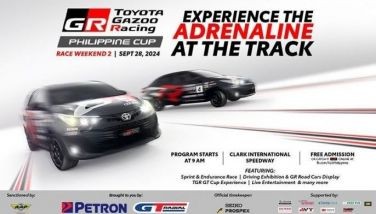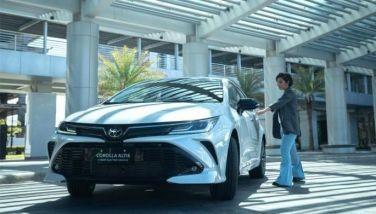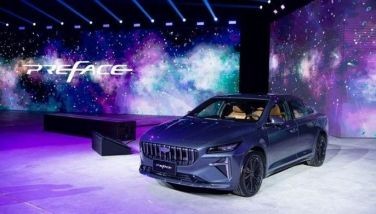Subaru Forester Turbo
September 27, 2006 | 12:00am
Here’s one car that’s targeted at a very narrow slice of the market: those that want an understated-looking 5-seat all-wheel-drive (AWD) wagon that can humiliate 9 out of 10 cars — including some pricey European sports sedans and modified Japanese tuner cars — in any stoplight grand prix.
I’m talking about the Subaru Forester Turbo. It looks almost exactly like its much humbler brother, the P1.25 million 2.0-liter normally aspirated Forester AWD wagon that develops an impressive 158 ps and 186 Nm of torque.
Cough up an extra P350,000, however, and you get an extra 500cc of displacement (to 2.5 liters), bigger 17-inch alloy wheels (up from 16), lower-profile 55-series tires, rear disc brakes, Electronic Brakeforce Distribution (EBD), a bad-boy hood scoop, leather seats, a huge 2-stage moonroof, side airbags (dual airbags only in the 2.0 Forester), and most importantly, a rousing 230 ps of power and a truck-like 320 Nm of torque courtesy of a turbocharger and an intercooler.
Result? An upmarket-feeling wagon cum SUV with an attitude. Lots of attitude. Floor the accelerator and hang on as the Forester Turbo literally whooshes you to 150 kph in the time it takes most cars to reach 100. Foreign magazines have clocked the Forester Turbo with a top speed of 215 kph and a 0-100 kph sprint of a little over 7 seconds — a mere second or so off a base Porsche Boxster. And this is with a 4-speed automatic! Subaru’s Prodrive (of WRC fame)-developed SportShift manumatic allows you to do the shifting yourself if you crave more driver involvement.
High-revving variable valve timing-equipped engines are nice, but nothing can take the place of a big-displacement turbocharged and intercooled gasoline powerplant when it comes to sheer accelerative force. Just ask any Mitsubishi Evo or Porsche 911 Turbo owner — two examples of high-performance all-wheel-drive gasoline-fed turbo cars. The smooth Porsche-like throb of the Subaru’s flat-6 motor only adds to the excitement. (Porsche and Subaru are the only two car companies currently producing horizontally opposed engines — a.k.a. boxer or flat engines — made popular by the Volkswagen Beetle, albeit in air-cooled form.
Considering its speed potential, the Forester fortunately has the stability (state-of-the-art full-time AWD plus low center of gravity from the horizontally opposed engine layout) and the braking power to rein in those triple digit speeds. The brakes, in fact, deserve special mention with the uncanny way they scrub off high speeds — right now! — with little effort and absolutely no drama.
Inside, the Forester is all business. No cutesy gimmicks or features — just the typical Japanese attention to detail with commendable, but not overwhelming, space for people and cargo and the usual array of practical storage areas and other comfort and convenience items. Build quality is high if not class-leading.
Our test model is actually the mid-cycle facelift of the Forester first marketed by GM Philippines some three years back. It’s not going to win beauty contests now, but it still looks good and enjoys a level of exclusivity that you won’t find in compact SUVs like the CR-V or RAV 4.
I’m talking about the Subaru Forester Turbo. It looks almost exactly like its much humbler brother, the P1.25 million 2.0-liter normally aspirated Forester AWD wagon that develops an impressive 158 ps and 186 Nm of torque.
Cough up an extra P350,000, however, and you get an extra 500cc of displacement (to 2.5 liters), bigger 17-inch alloy wheels (up from 16), lower-profile 55-series tires, rear disc brakes, Electronic Brakeforce Distribution (EBD), a bad-boy hood scoop, leather seats, a huge 2-stage moonroof, side airbags (dual airbags only in the 2.0 Forester), and most importantly, a rousing 230 ps of power and a truck-like 320 Nm of torque courtesy of a turbocharger and an intercooler.
Result? An upmarket-feeling wagon cum SUV with an attitude. Lots of attitude. Floor the accelerator and hang on as the Forester Turbo literally whooshes you to 150 kph in the time it takes most cars to reach 100. Foreign magazines have clocked the Forester Turbo with a top speed of 215 kph and a 0-100 kph sprint of a little over 7 seconds — a mere second or so off a base Porsche Boxster. And this is with a 4-speed automatic! Subaru’s Prodrive (of WRC fame)-developed SportShift manumatic allows you to do the shifting yourself if you crave more driver involvement.
High-revving variable valve timing-equipped engines are nice, but nothing can take the place of a big-displacement turbocharged and intercooled gasoline powerplant when it comes to sheer accelerative force. Just ask any Mitsubishi Evo or Porsche 911 Turbo owner — two examples of high-performance all-wheel-drive gasoline-fed turbo cars. The smooth Porsche-like throb of the Subaru’s flat-6 motor only adds to the excitement. (Porsche and Subaru are the only two car companies currently producing horizontally opposed engines — a.k.a. boxer or flat engines — made popular by the Volkswagen Beetle, albeit in air-cooled form.
Considering its speed potential, the Forester fortunately has the stability (state-of-the-art full-time AWD plus low center of gravity from the horizontally opposed engine layout) and the braking power to rein in those triple digit speeds. The brakes, in fact, deserve special mention with the uncanny way they scrub off high speeds — right now! — with little effort and absolutely no drama.
Inside, the Forester is all business. No cutesy gimmicks or features — just the typical Japanese attention to detail with commendable, but not overwhelming, space for people and cargo and the usual array of practical storage areas and other comfort and convenience items. Build quality is high if not class-leading.
Our test model is actually the mid-cycle facelift of the Forester first marketed by GM Philippines some three years back. It’s not going to win beauty contests now, but it still looks good and enjoys a level of exclusivity that you won’t find in compact SUVs like the CR-V or RAV 4.
BrandSpace Articles
<
>
- Latest
Latest
Latest
September 30, 2024 - 4:26pm
By EC Toledo | September 30, 2024 - 4:26pm
September 26, 2024 - 3:30pm
September 26, 2024 - 3:30pm
August 16, 2024 - 11:00am
By Euden Valdez | August 16, 2024 - 11:00am
Recommended






























